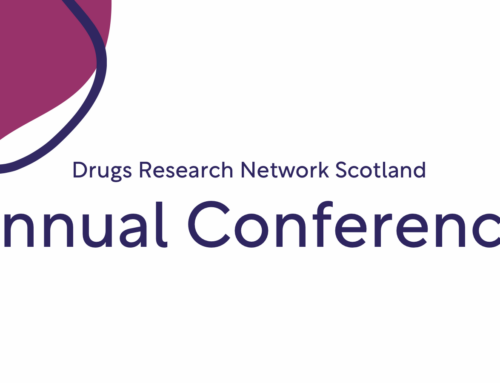Chatting with Professor Richard Velleman – Part Two

Part two: Conferences and The Addiction and the Family International Network (AFINet)
This is the second of a two-part blog series with Professor Richard Velleman. In the first blog, Professor Velleman talked about the fascination and challenges of working in the field of children and families affected by substance use, and in this blog, he talks about his involvement with AFINet and their last conference.
DRNS: The last AFINet conference in September 2021 was online, do you feel it went well?
Professor Velleman: “Part of the function of AFINet is networking, so drawing people together, and hearing what people are doing in different countries is very important. We had a 133 people who registered for the conference from 26 countries. About 15% were from England, 8% from each of New Zealand, Finland, South Africa, Ireland, and 7% USA. Plus, we had people from another 20, 21 countries from across the world. It was absolutely amazing. Over 80% of the 133 attendees were members, and AFINet is free to join, so you’re very welcome to become members.”
DRNS: What, for you, were the highlights of the conference?
Professor Velleman: “There were a number of important themes that came across.
- The importance of partnerships and collaborations between researchers on the one hand and service providers on the other. Service providers were either family-led organisations or professionally led organisations. These partnerships are two-way: organisations often provide the data that the researchers are interested in, and then these same organisations use the results of the research in their submissions arguing for funding. So, a major theme was these very helpful partnership relationships and collaborations.
- How serious and significant harm to families was across the world. We had presentations from New Zealand, Zimbabwe, South Africa, Italy, Scotland, Malaysia, Germany, USA, Canada, Holland, Iceland, and Norway. Our initial research, all those years ago, found what we’re still finding now. The similarities are remarkable. There are cultural differences, but the similarities are remarkable.
- The importance of availability of gambling, or alcohol or drugs, or over-the-counter medications in fuelling the addiction problem in the lives of our family members and their relatives. Also, the importance of availability, or the lack of it, in temporarily reducing the addiction problems. The impact of COVID-19 has been very interesting. In countries where they suddenly went dry, alcohol problems, including alcohol withdrawal, increased a lot, but alcohol problems in general, went down because people couldn’t get hold of alcohol. Gambling problems went up because internet gambling was still very available and lots of people moved everything online. Drug problems tended to go down because of availability, because the drug corridors couldn’t work because people were being stopped from travelling.
- How long peoples’ lives have been blighted by having someone in the family with an addiction problem, with these family members receiving absolutely no help. It is not necessarily the case that the person with the addiction problem has received no help, even though that’s often the case, but this theme was about the family members themselves receiving no help. Also, how, even if things start to change, the anxiety doesn’t diminish and often gets worse when things start to change, due to the anticipation that the relative is going to relapse. So, when person with the problem starts to change, there’s some assumption that the family member is going to immediately breathe a sigh of relief and say, “oh, thank goodness, life is going to go back to the way it was”. That’s not what often happens: instead, your anxiety increases. People worry even more that they may say the wrong thing, the person may relapse, it may be their fault (even if it’s not their fault), they may be blamed for it.
- Families want no stigma, no assumptions, no judgment. One of the reasons why the 5-Step Method has been very helpful to lots of people is that it has a very explicit non-stigmatising, non-judgmental approach. We do not blame family members. We don’t get caught up in discussions about whose fault it may have been. We’re interested in something which is future-looking rather than past-looking.
- The extraordinary commitment that so many providers have in ensuring their services run and provide help to those who need it. Even when funding dries up, even when they can’t see people face-to-face and so on.
- How so many people accept technological solutions, for example, help delivered by Zoom. Many speakers at the conference recognised that there were circumstances where Zoom was either necessary, or for some people, better. Many people have told service providers that they would not have come to a face-to-face meeting and wouldn’t have walked through a door and labelled themselves as an affected family member, so doing it on Zoom and not having to leave your home has huge positives. However, many people also said they did prefer physical face-to-face interactions, and the vast majority of service providers said they far preferred face-to-face interaction. Many providers assumed that people wouldn’t like Zoom because they didn’t like Zoom. It was a surprise to them that actually lots of people did like Zoom, even though they didn’t.
- How many people are affected by someone else’s alcohol, drug, or gambling problem. We’ve always erred on the side of not exaggerating. We often speak of one person affected by each user, maybe two. Dr Justina Murray did a presentation about her work in Scotland, where she showed that, on average, 11 people were affected by each serious drug, alcohol, or gambling problem. That’s an order of magnitude which is massively greater than we have been saying. I see some of our estimates quoted in lots of other papers, where we’ve estimated that maybe there’s a hundred million people with addiction problems, so, that’s a hundred million affected family members across the world. Well, I think a hundred million people with an addiction problem is probably a low estimate. But even if it were to be ‘only’ one hundred million people with their own addiction problem, using Justina’s figures, instead of that being hundred million affected family members, it would be one billion affected family members. It’s quite phenomenal the numbers we’re talking about.
- How training is needed for people who come in contact with people with alcohol, drug or gambling problems. They may come into contact as an affected family member, or it may occur due to their professional role, but they need training and skills in how to deal with their own feelings of upset, anxiety, depression, guilt, and so on. A lot of service providers are very badly affected by dealing with the impact of what they hear from affected family members, and they don’t get very much help. There’s a lot of training that’s needed, both for family members and for service providers.”
DRNS: What, for you, was the key takeaway message of the conference?
Professor Velleman: “For me, I think it was about getting a balance between top-down policy driven approaches, and a bottom-up, hearing-the-lived-experience-of-family-members and developing services which are very in tune with what these people are saying, and helping them have a voice, an advocacy voice. Services are often set up by affected family members, so bottom-up stuff is really important, but without some top-down policy interest, it’s very difficult for them to get any traction. So, we need to bridge the top-down and the bottom-up by enabling family members to be advocates to those policy people. We’ve got to understand the psychology of how to get policy change.
What I’ve learned over the years from politicians, is that that although we as academics realise how important research is and how relatively unimportant single case studies are, for politicians, it’s the other way around. It’s the single case study which has the impact. When a politician can stand up in Parliament and say, “I was contacted by Mrs Jones, one of my constituents. Let me read from her letter…”. As academics, we think “that’s one-off, who knows if her experiences are in any way generalisable, we’re not going to be developing national policy because Mrs Jones wrote to her MP with her particular experiences. That’s not a weapon”. We know that we need to have a much broader research base in order to know what is and isn’t needed, but for politicians, the single cases, the advocacy, the voice of the end user is actually what motivates them to do things and motivates other people to vote in favour of what they’re talking about.”
Professor Velleman’s takeaway message regarding evidence and case studies links to the point raised in an earlier blog by Professor Matheson, where she talked about the challenge academics have in encouraging politicians to understand what evidence means. What do you think? Perhaps you’d consider writing a blog post of your own about this topic? Let us know.
If you want to find out more about the work being done by Professor Velleman and his colleagues across the world, visit The AFI Net website which contains access to past and upcoming webinars and lots of other useful information.
The 2022 AFINet conference will take place on 29-30 September 2022. If you would like to submit an abstract to present at the conference, or would like tickets to attend, keep your eye on the AFINet website for updates or look out for news in the DRNS newsletter (sign-up, here).




